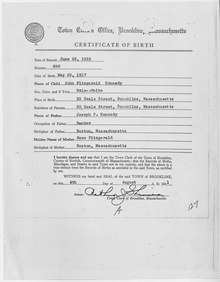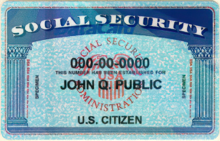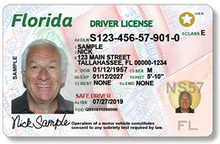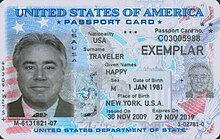ID (United States)
Official identification in the United States is state , not federal. There is no document corresponding to the identity card . Due to the mutual recognition by the US states and the almost nationwide implementation of a federal law ( REAL ID Act ) on the design and content of identification documents, the driver's license and the state ID of the US states with the same content has de facto developed into a nationally valid ID document .
history
Since at the time of the American Constitution of 1789 by far the largest number of state tasks were taken over by the states, counties and municipalities , a uniform ID card for the entire USA was not necessary at that time. With the advent of the automobile and its subsequent regulation, driver's licenses became the most widely used identification document . This was particularly associated with suburbanization in the United States in the mid-20th century and the simultaneous increase in demand for automobiles.
In the past, proposals were repeatedly brought to the Congress that would have created a nationally valid ID card. Such proposals were always criticized by many as the first steps towards a totalitarian state and were therefore politically unsustainable.
As a result of the September 11, 2001 attacks and attempts to prevent future attacks, Congress passed the Real ID Act on May 10, 2005 . While this law does not create a uniform ID, it does determine which standards must be met for driver's licenses and other IDs issued by the states .
Birth certificate
The birth certificate is the first document of identity given to you at birth in your local hospital in the United States . This birth certificate is issued by the state and county in which the birth occurs. Its significance derives from the 14th Amendment to the United States Constitution , according to which citizenship is linked to birth in the United States (with exceptions for foreign-born children of US citizens). As a rule, the birth certificate serves as proof of citizenship.
Although the first registrations, following English models, were introduced in the Massachusetts Bay Colony as early as 1639, in 1833 only six cities (Boston, New York, Philadelphia, Baltimore, New Orleans) actually had birth and death records. A state birth register was first introduced in Massachusetts by Lemuel Shattuck in 1844 and was initially only reluctantly adopted by other states. It was not until 1902 that a national birth register was introduced on the initiative of the United States Census Bureau . For individual citizens, apart from statistical purposes, they only became important in the 1930s when, for the first time, numerous citizens had to prove not only their citizenship but also their age. During the Second World War, laws were passed against the employment of foreigners, which required proof of citizenship. At that time, birth certificates were only issued for this purpose on special request, with the requests being subject to a fee and often being processed late due to the high demand. In 1940 an estimated 55 million US citizens had no birth certificates. Only after the war, in 1946, were uniform standards created with the establishment of the National Office of Vital Statistics. The birth must be reported by doctors or midwives to the local authorities who will issue the birth certificate between 24 hours and 10 days after the birth, depending on the state. The form and content of birth certificates have not yet been standardized nationally, although data are routinely passed on to the National Office of Vital Statistics.
Social security card
This document is usually issued by the Social Security Administration at the request of the parents . Usually, shortly after the birth, the parents apply for a social security card, because a social security number is associated with it. You can then register your child as a dependent family member with the US Inland Revenue Service (IRS) so that they can be considered on your next tax return.
The original purpose of the social security card was to simplify notifications of wage payments and the calculation of related social benefits. After the employee retired, he could then apply for his pension with this data.
The social security number is an example of a gradual function shift. On the basis of an executive order by President Franklin D. Roosevelt (1942) to use the social security number as the primary key in all newly created records , the US Inland Revenue Service (IRS) (1961) began to use it for its own purposes.
There has been strong concern in civil and religious circles about using the social security number as a national identification number. This prompted the Social Security Administration to label the social security cards with the words: "For social security purposes - not for identification" (new cards issued between 1946 and 1972).
The US federal government enacted the Privacy Act in 1974 , which prohibits the forced use of the social security number by government agencies. The only exception to this are government agencies that are expressly authorized or even required to use the social security number. The Privacy Act applies to any government agency attempting to collect the social security numbers. It also regulates the authorities to which you have to give your social security number. The resolution of the US Congress that the Department of Motor Vehicles may also issue social security numbers when issuing driver's licenses is controversial . However, the Privacy Act of 1974 extends only to government agencies.
The first three digits of the social security number allowed the issuing state to be inferred until 2011 . The other six digits are essentially random numbers . A block of consecutive numbers is used for each calendar day. There are no checksums .
In the absence of a national identity document, the social security number has de facto become the national identifier for tax purposes and credit checks. Because of the increasing number of identity thefts in recent years, there have been various proposals for a national identity document.
Many organizations, universities and companies used to use the social security number to uniquely identify their customers or students. However, you have bowed to the public demand that the social security number be used exclusively for government purposes and credit matters. Instead, they now assign their own customer numbers when they first come into contact with the person concerned and only ask for their social security number if it is absolutely necessary.
Some US states have passed laws requiring non-governmental agencies to only issue their own unique identity numbers, and specifically forbidding the use of the Social Security number as a primary key.
Driving license
In practice, the driver's license is the most widely used adult identity document in all states. When driving a vehicle, it must always be taken with you and shown to the police on request as long as you are in the vehicle. The driver's license issuing authority also issues identity documents with a passport photo (State ID) to non-drivers. These are especially children, elderly citizens and people who have had their driving license withdrawn.
There is no legal obligation to carry your driving license with you at all times - even when you are not using a vehicle. Even so, most American adults carry their driver's license with them at all times. According to a ruling by the US Supreme Court , the US states may require people to give their names when asked by the police. Furthermore, in some US states (e.g. California ) it is mandatory to present an identification document upon request after a traffic violation. This also applies to traffic violations when using a bicycle (e.g. driving on the wrong side of the street). Failure to present an identity document after a traffic violation is a sufficient reason for a preliminary arrest .
In addition, there are agreements between the US states and various states ( Canada , Mexico ) on the mutual prosecution of traffic violations . Traffic violations in other US states or neighboring countries will be punished by the US state that issued the driver's license.
To improve the security of driver's licenses, some US states compare the passport photo with a photo database that contains several million driver's license photos when issuing or renewing a driver's license. The driver's licenses are also increasingly provided with forgery-proof features, for example holograms , visible and invisible digital watermarks .
The US Congress passed a controversial law ( REAL ID Act ) in 2005 , which technically converted the official driver's license into a national identification card . The Department of Homeland Security was in charge of creating a national identification card , with the authority to determine the design and content of all driver's licenses in the various US states. The Department of Homeland Security requires that all related state databases be linked into a single national database. However, this driver's license is still issued by the US states and not by the US government , as the states have the regulatory authority for it. Part of the law is that US federal agencies will no longer recognize driver's licenses, State IDs and other forms of identification that do not comply with the REAL ID Act by a certain point in time (currently October 2020) as proof of identity . So z. B. Domestic flights and the application for a passport with these documents are no longer possible. In order to avoid disadvantages for their citizens, all but three states of the US have implemented the Real ID Act . (As of 2019)
The driver's license and State ID are mutually recognized by all states as valid identity documents. The basis for this is that laws of the individual US states are to be recognized in every other state ( Article 4 of the US Constitution : Full Faith and Credit Clause ). This in connection with the almost nationwide implementation of the REAL ID Act have de facto developed the driver's license and the State ID into a nationwide valid ID document.
Outside of use by authorities, private companies often require the presentation of a driver's license for identity verification, especially when using credit cards or buying cigarettes or alcoholic beverages . The retailer does not actually need to be presented with a photo ID (e.g. driver's license) when presenting a signed credit card. VISA even contractually forbids this procedure.
Car insurers regularly request the number of the driver's license when taking out vehicle insurance . The car insurers have direct access to the driver's license data and the associated traffic offender files so that they can assess the insurance risk.
The driver's license didn't start out as an ID card. The first US driver's licenses initially only contained the name, driver's license number and possibly the address. They should make it easier for problematic drivers to prosecute. Driving licenses were introduced in most US states by the late 1930s.
Over time, additional data was added to driver's licenses: height, weight, eye color , hair color , gender , and sometimes race . This should prevent the misuse of driving licenses. While almost all driving licenses come with a passport photo , the personal description on the driving license is a relic from the times when the driving licenses did not have passport photos. In the early 1960s, the first US states began adding color passport photos to driver's licenses. All US states have been issuing driver's licenses with passport photos since the mid-1980s - however, passport photos were not mandatory in all states.
Vermont has only required all newly issued driver's licenses to include a passport photo since 2004. The old driver's licenses without a passport photo can still be used until they expire. New Jersey ended the issue of driver's licenses without a passport photo in 2004. Driving licenses without a passport photo were exchanged until 2008.
Tennessee does not require the elderly (over 60 years of age) to have a passport photo on driver's licenses. In addition, drivers license applicants in Tennessee who cannot provide proof of their residence permit in the USA or who are only staying in the USA on a short-term visa receive a special driver's license with a passport photo ( Certificate for Driving ) with the inscription "Not for identification purposes".
The various US states have different regulations on how to proceed in special cases (religious objections to photos or to photos without headgear) when issuing driver's licenses without a passport photo.
Since 2005, all US states have issued “digital” driver's licenses. The digital photo ID cards (photo cards) use digital photos . As a side effect, the digital passport photos can be archived electronically. The states seldom clearly indicate this to the applicant. The law enforcement authorities have unrestricted access to these photos without any additional judicial order. However, the unauthorized disclosure of photos to other non-law enforcement agencies is prohibited by law ( Federal Driver's Privacy Protection Act ).
There was public outcry in the late 1990s when it became known that some states were selling driver's license photos and home addresses to marketing and database companies.
The murder of the 21-year-old actress Rebecca Schaeffer (1989, Los Angeles, California) by a fanatical admirer became known in the USA . He pursued her for three years and finally got her home address (fee: US $ 250) through a private detective, who in turn had it from the California Vehicle Registration Authority. The mentally ill suitor rang the doorbell at her front door, was turned away by her, rang again after an hour and shot her at her front door. This murder case was a trigger for the Driver's Privacy Protection Act, which drastically restricted the disclosure of personal data by the vehicle registration authority and driver's license authority (Department of Motor Vehicles). The American stalking laws were also tightened as a result.
Some US states (including California , Texas , Hawaii , Colorado ) require a fingerprint for driver's license issue. In California and Colorado, fingerprints used to be archived on fingerprint cards. Today, however, only thumbprints are taken and archived electronically.
Georgia has been collecting thumbprints for driver's license issue since 1996. However, because this practice is very unpopular, it was ended in 2006 and the existing thumbprint archive was destroyed.
The law enforcement agencies do not use the fingerprints of driving licenses because they do not have sufficient forensic significance. The fingerprints are also not compared with each other for security purposes, since the number of fingerprints collected is still too small.
Federal law requires driver license applicants to be fingerprinted to transport dangerous goods in all states. However, these are not required for the actual issuing of the driver's license, but only serve the mandatory security check by the FBI .
In 48 states, the Department of Motor Vehicles (or an equivalent US federal government agency ) is responsible for issuing and managing driver's licenses and ID cards. The US states of Hawaii and Kentucky have delegated driver license and vehicle registration to the subordinate local county administration.
passport
American passports are issued by the U.S. Department of State . Typically, passport applications are sent in the mail ( US Postal Service Office ) or can be picked up at local administrative offices.
No passport was required for re-entry from neighboring countries ( Canada , Mexico , Bermuda , Caribbean and Central American countries) until 2005 (the exception is entry by air). After June 30, 2009, a passport is required when re-entering the country, which is why the Passport Card was created as a simple document.
Passport Card
In addition to the passport , the Passport Card in credit card format has also been available since 2008 . The card is a full-fledged passport for US authorities and is issued by the State Department and can be used by US nationals to travel by land and sea within North America and the Caribbean, as well as on domestic flights. Unlike a driver's license, State ID, and social security card, the Passport Card or passport certifies possession of US citizenship
Other special cards
In the absence of a nationwide identity card, the average American carries a large number of other IDs.
Examples:
- Credit cards and check cards
- Organizational identification cards (company, university, school)
- Professional ID cards (professional representation)
- Proof of liability insurance (for drivers)
- Health insurance card (from private health insurance, Medicare, or state health insurance)
- library card
- Membership card in private clubs or associations (social, sport, education, student association)
- Membership cards of private companies (bonus cards, club cards - e.g. supermarket or department store)
- Membership card from professional organizations
- Membership card from private associations
- Access cards from private or government agencies (press card, stage pass)
ID tag
When entering many American companies or security agencies, all employees must wear a clearly visible name tag, an ID tag (often with a photo). An ID tag is also made for visitors when they enter the building or the facility.
Web links
proof
- ^ Vital Records Documents Issued in the United States. USA.gov, from the official website of the United States government. Retrieved March 30, 2017.
- ↑ Alice M. Hetzel: US vital statistics system: major activities and developments, 1950-95. US Department of Health and Human Services, National Center for Health Statistics, DHHS Publication 97-1003. download
- ↑ Code of Federal Regulation - 6 CFR Part 37
- ^ Transportation Security Administration: Identification , accessed August 31, 2019
- ^ Department of Homeland Security: REAL ID , accessed August 27, 2018.
- ↑ U.S. Department of State: Passport Card , accessed August 27, 2017






